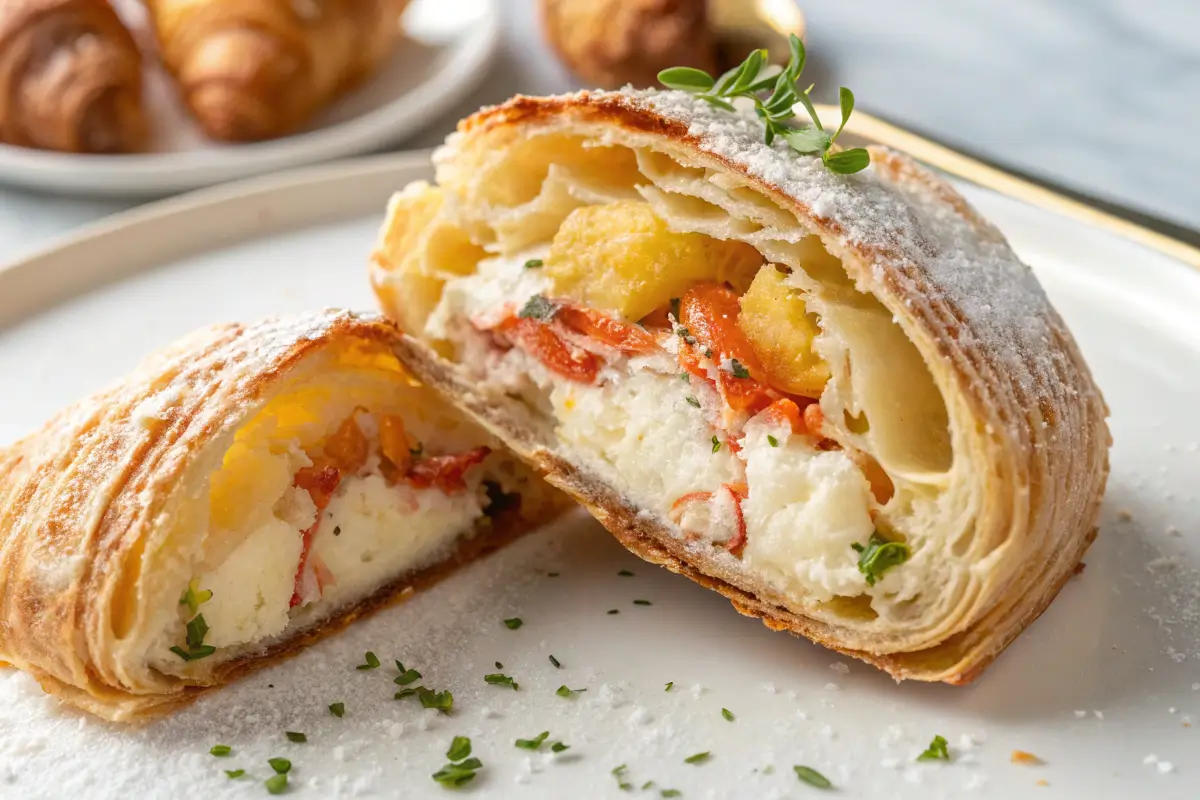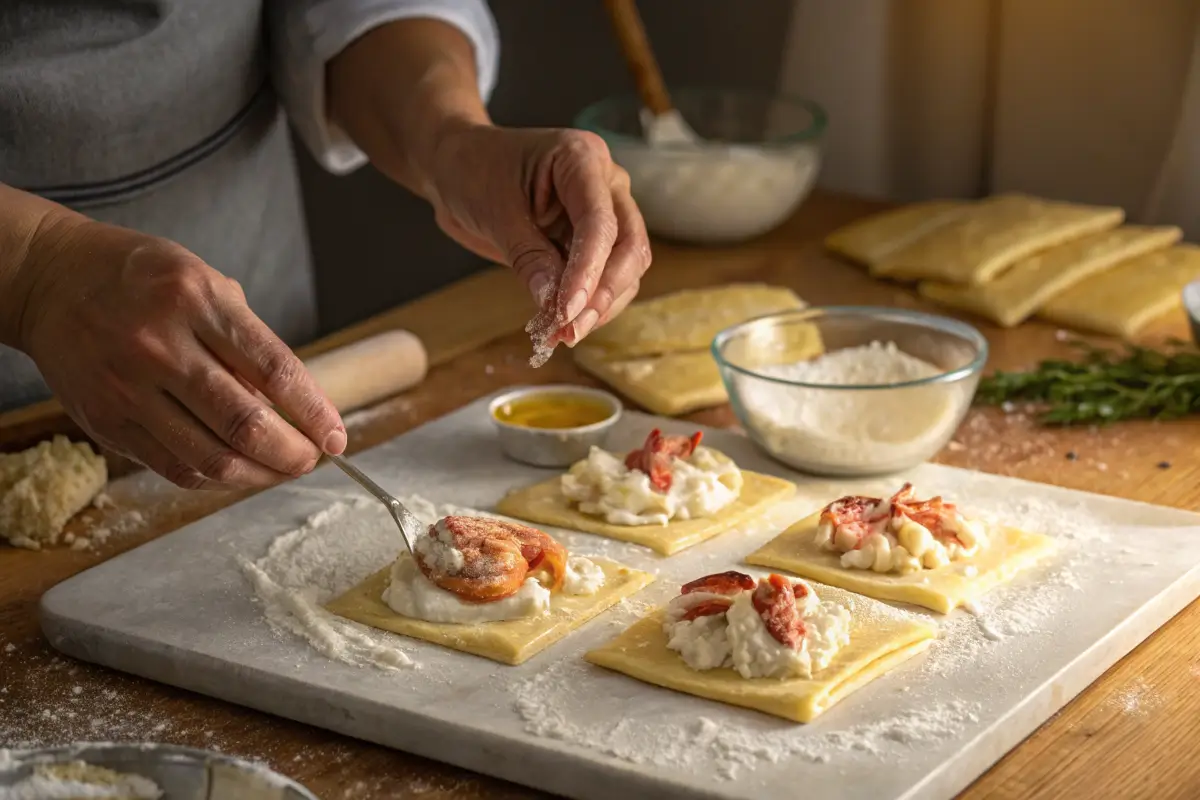Craving a taste of Italy? Then get ready to discover the lobster tail pastry, a delectable treat that’s as beautiful as it is delicious! This article will take you on a journey through the sfogliatella’s fascinating history, break down its iconic construction, and even explore ways you can make a simpler version right in your own kitchen. So, get your sweet tooth ready, because we’re about to dive deep into the world of this crispy, creamy masterpiece! We’ll also cover where to find the best ones and how they compare to other similar pastries. Plus, we’ll answer some frequently asked questions to make you a sfogliatella expert!
What is Lobster Tail Pastry (Sfogliatella)? A Delicious Introduction
Unveiling the Lobster Tail Pastry:
Okay, so what exactly is a lobster tail pastry? Well, it’s a scrumptious Italian treat, more formally known as sfogliatella (pronounced sfoh-lee-ah-TEL-lah). Its roots are deep in Naples, Italy, and you’ll often find it in Italian-American bakeries. The name comes from its distinct shape – it’s crafted to look a bit like a lobster’s tail. Layers of thin, crispy dough surround a creamy ricotta filling, often flavored with hints of citrus or vanilla. Lightly dusted with powdered sugar, it’s both visually stunning and irresistibly delicious. Perfect with coffee or enjoyed on its own, this pastry is a classic example of Italian baking at its finest.
A Quick Look at the Texture and Flavors of Sfogliatella:
As you bite into this pastry, get ready for an explosion of textures. The shell is super crispy and flaky, giving way to a sweet filling. Traditionally, this filling is a ricotta cheese mixture, often infused with citrusy goodness. But, hey, there are variations out there! Some sfogliatelle feature almond paste, custard, or even a bit of both. It is truly a treat for the senses. The contrast between the delicate, crunchy layers and the creamy, flavorful filling is pure magic. Add to that the subtle aroma of orange or lemon zest, and each bite feels like a little taste of Italy. Whether you prefer it warm from the oven or cooled to perfection, this pastry is guaranteed to leave you craving more.
The History and Origins of the Sfogliatella
Tracing the Sfogliatella’s Roots to 17th-Century Italy:
The sfogliatella boasts a pretty interesting past! It all began way back in the 17th century, inside a convent. Specifically, it was the Santa Rosa monastery, near Conca dei Marini on the Amalfi Coast. Seems like the nuns were quite the bakers! Legend has it that one of the nuns experimented with leftover semolina, combining it with ricotta, dried fruit, and sugar to create the now-famous filling. This mixture was then wrapped in delicate layers of dough, resulting in the signature shell-like shape. Originally named “Santa Rosa” after the monastery, the pastry eventually made its way to Naples, where it was refined and became the beloved sfogliatella we know today.
From Convent Kitchen to Worldwide Delight:
Eventually, this delicious secret got out. Pasquale Pintauro, a clever baker from Naples, got his hands on the recipe and tweaked it a bit. And just like that, the sfogliatella took off! Pintauro opened a bakery in Naples in the 19th century, turning this once-monastic treat into a citywide sensation. His version preserved the delicate, flaky layers while making the pastry more accessible to the public. Nowadays, you can find it all over the world, especially in Italian-American bakeries, where it’s become a real favorite. From its humble beginnings in a convent to its global fame, this lobster tail pastry has had quite the journey! It continues to delight pastry lovers everywhere, proving that great recipes truly stand the test of time.
Breaking Down the Anatomy of a Perfect Lobster Tail Pastry
The Art of the Shell: Layers of Perfection:
First off, let’s talk about that incredible shell. Creating it is truly an art! It involves carefully layering thin sheets of dough, a process that requires both precision and patience. Typically, bakers use butter or lard to achieve that signature flakiness, carefully folding and rolling the dough to create those delicate layers. This makes the lobster tail pastry shell irresistibly crispy, with each bite delivering a satisfying crunch. The dough is rolled out so thin that it almost seems translucent, allowing the outer layers to puff up beautifully during baking, creating that perfect balance of texture. The result is a shell that’s light, crisp, and golden, providing the perfect contrast to the smooth, creamy filling inside.
The Heart of the Pastry: The Filling Options:

Next up, the filling! Traditionally, it’s ricotta-based, giving it a creamy sweetness that’s simply irresistible. However, you’ll find all sorts of variations depending on the region and baker’s preferences. Some recipes call for almond paste, adding a nutty richness, while others opt for pastry cream, which gives a smooth, custardy texture. And, of course, candied citrus is a popular addition, lending a bright, zesty flavor that cuts through the richness of the filling. Whether it’s a simple ricotta blend or a more complex mix of ingredients, the filling is what makes each bite of sfogliatella a true indulgence, offering a perfect balance of sweetness and flavor.
Adding That Sweet Touch:
Finally, don’t forget that little something extra! The addition of orange zest is key in giving the lobster tail pastry its distinctive flavor. It perfectly complements the richness of the ricotta and adds a delightful aroma that fills the air as soon as you take a bite. The citrusy notes cut through the sweetness, balancing the pastry and elevating the entire experience. Whether it’s a subtle hint or a more pronounced burst of zest, that touch of orange creates a truly unforgettable flavor profile, making each sfogliatella uniquely delicious. It’s the kind of detail that makes all the difference in creating a pastry that’s both decadent and refreshing. You might even enjoy it more if it reminds you of a Exploring Amalfi Lemon Cake. The lobster tail pastry is more than the sum of its parts.
Making Lobster Tail Pastry at Home: A Simplified Approach

Challenges of Homemade Sfogliatella:
Alright, let’s be real – making a lobster tail pastry from scratch, the traditional way, is no walk in the park! It’s a complex process with lots of steps, from carefully preparing the dough layers to perfecting the filling. It requires a fair bit of time, skill, and patience to get everything just right. Therefore, many home bakers opt for easier versions, often using store-bought puff pastry or simplifying the filling. While it may not capture every detail of the classic version, these shortcuts still result in a delicious treat, allowing you to enjoy the essence of the lobster tail pastry without the hassle of a lengthy process. Similarly, other desserts, like this Gluten-Free Carrot Cake Recipe , can require some skill to make.
Simplified Recipe Overview:
So, what’s the secret to a simpler approach? Puff pastry! Using store-bought puff pastry as a base is a total game-changer. For the filling, mix ricotta cheese with sugar and your favorite flavorings, like vanilla or that essential orange zest. If you’re feeling ambitious, you can try a more traditional approach following this recipe from Allrecipes which details how to make it from scratch, with the signature flaky layers.
(Simple Sfogliatella-Inspired Bites Recipe – Serves 2. Adjust quantities proportionally for larger groups.) If you want to try making something similar to a lobster tail pastry at home, here’s a quick recipe for delicious ricotta-filled bites.
Ingredients:
-
1 sheet of puff pastry
-
1 cup ricotta cheese
-
2 tablespoons sugar
-
1 teaspoon vanilla extract
-
1/2 teaspoon orange zest
-
Powdered sugar for dusting
Method:
Preheat oven to 375°F (190°C). Cut puff pastry into squares. Mix ricotta, sugar, vanilla, and orange zest. Place a spoonful of the mixture on each square. Fold the pastry over to form a triangle or rectangle. Bake for 15-20 minutes, or until golden brown. Dust with powdered sugar before serving.
Nutritional Content (per 100g):
Keep in mind this is an estimate, and the actual nutritional content of a lobster tail pastry will vary depending on the recipe.
| Nutrient | Amount (Approximate) |
|---|---|
| Calories | 350-450 kcal |
| Fat | 20-30g |
| Saturated Fat | 10-15g |
| Carbohydrates | 30-40g |
| Sugar | 15-25g |
| Protein | 8-12g |
Baking and Finishing Touches:
Finally, it’s time to bake. Pop those lobster tails into a preheated oven (around 375°F or 190°C) and bake until they’re golden brown and puffy. Once they’ve cooled, give them a generous dusting of powdered sugar for that perfect finishing touch. While not exactly the same as the real deal, perhaps you want to try something different, you can also discover the delightful sweetness of other options, like exploring the flavors in this Strawberry Cheesecake Cookies recipe. While not exactly the same as the real deal, it’s a tasty way to enjoy a lobster tail inspired treat.
Finding the Best Lobster Tail Pastries: Where to Buy
Italian-American Bakeries: A Sure Bet:
Generally speaking, your best bet for finding a fantastic lobster tail pastry is an Italian-American bakery. They’re practically synonymous with this classic dessert! Places like New York and Boston have a particularly strong tradition of amazing Italian bakeries, so you’re likely to find them there.
Online Options for Lobster Tail Delivery:
Alternatively, if you don’t have a great bakery nearby, don’t worry! Many online bakeries now ship sfogliatelle right to your door, so you can enjoy this delicious treat without leaving home. Just do a quick search for “Italian bakery delivery,” and you’re sure to find a few options offering fresh, authentic pastries delivered straight to you. Whether you’re craving a traditional sfogliatella or a creative twist on the classic, these services make it easy to indulge in Italian pastries no matter where you are. It’s a perfect solution when you’re in the mood for something special but can’t find it locally!Or, if you’re in the mood for a totally different kind of dessert experience, perhaps you’d like to check a Taco Bell Desserts Guide. Thus, satisfying your craving is easier than ever.
Lobster Tail Pastry Around the World: Variations and Adaptations
Regional Twists on the Classic:
While the traditional lobster tail pastry is a beloved classic, you’ll find subtle variations depending on where you are. Some regions might use different spices in the ricotta filling, for instance, adding a hint of cinnamon or nutmeg for a warm, aromatic twist. In other areas, bakers might incorporate different citrus zest, such as lemon or even a mix of orange and grapefruit, to give the pastry a unique flavor profile. There are also variations in the dough itself—some regions may opt for a slightly sweeter dough, while others stick to the more savory, buttery base. These regional differences highlight the versatility of the sfogliatella, showing how this pastry has evolved while maintaining its delicious core.
Fusion Creations:
Moreover, creative bakers are always putting their own spin on things. From chocolate-filled sfogliatelle to those incorporating exotic fruits, there’s no limit to the possibilities. These fusion creations show the lobster tail pastry’s versatility.
Pairing Suggestions: Enhancing Your Sfogliatella Experience
The Perfect Coffee Companion:
Without a doubt, the sfogliatella pairs beautifully with a strong cup of coffee. Espresso, in particular, is a classic choice that cuts through the sweetness, balancing the rich, creamy filling with its bold, robust flavor. The slight bitterness of the espresso contrasts perfectly with the pastry’s sweetness, making each bite even more satisfying.
Wine Pairing Options:
In addition, if you’re feeling fancy, consider a sweet dessert wine. Vin Santo, an Italian dessert wine, complements the flavors of the lobster tail pastry wonderfully. Its smooth, honeyed notes work in harmony with the citrusy and creamy filling, adding a touch of elegance to the experience. For a slightly lighter option, a Moscato d’Asti could also be a delightful choice, offering refreshing sweetness and effervescence that pairs well with the pastry’s richness.
Lobster Tail Pastry vs. Similar Pastries: A Quick Comparison
Sfogliatella vs. Aragostine:
The lobster tail pastry, or sfogliatella, is often compared to aragostine. Ultimately, the difference lies in the shape and texture. Both share a similar flaky shell and ricotta filling, but aragostine tends to be slightly more elongated.
Sfogliatella vs. Other Italian Pastries:
Also, it’s worth comparing sfogliatella to other Italian favorites like cannoli. While cannoli have a fried shell and creamy filling, sfogliatelle stand out with their distinctive layered pastry. The cannoli shell is crunchy and often more delicate, while the sfogliatella’s flaky layers provide a more substantial bite. Additionally, cannoli typically have a sweet ricotta filling mixed with chocolate chips or candied fruit, whereas sfogliatella often features a more subtly flavored ricotta mixture, sometimes with citrus zest or even almond paste. Both are iconic in their own right, but the sfogliatella’s unique texture and layered dough give it a special place among Italy’s sweetest treats.
FAQs
Is a lobster tail pastry the same as sfogliatelle?
Yes, sfogliatelle is the formal Italian name for what’s commonly known as a lobster tail pastry.
What is the pastry they eat in The Sopranos?
Although various Italian pastries appear in the show, sfogliatelle are among the most iconic.
What is a lobster tail puff?
Essentially, it’s another name for a lobster tail pastry, emphasizing its light and airy texture.
What is the difference between aragostine and sfogliatelle?
Basically, they’re very similar, but aragostine can have a slightly different shape and filling variation. They’re both delicious takes on the same concept.
So, there you have it – a deep dive into the delicious world of the lobster tail pastry! Whether you’re grabbing one from your local Italian bakery or trying your hand at a simpler version at home, this iconic treat is sure to delight. We hope you enjoyed learning about this flaky, sweet masterpiece. Now, what are your favorite ways to enjoy a sfogliatella? Share your thoughts and experiences in the comments below!

